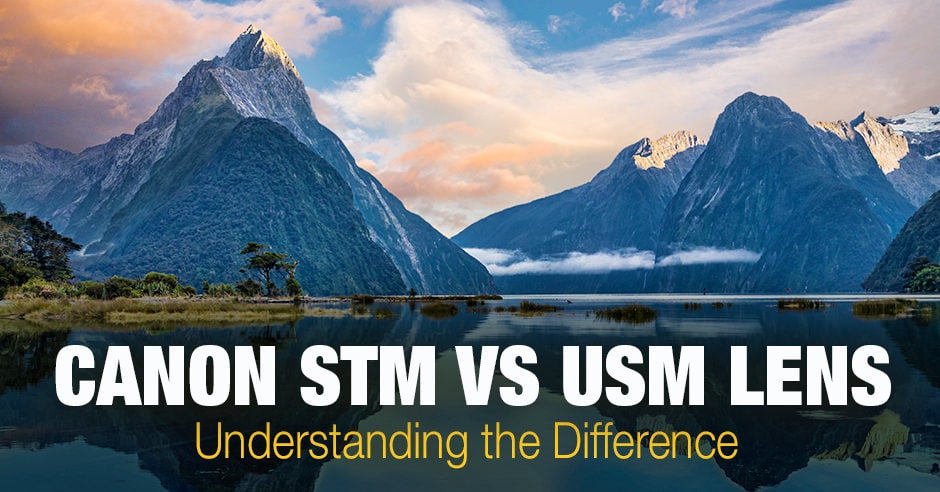Do you want to know the difference between a Canon STM vs USM lens?
If you’re trying to pick a lens, you may find
yourself confronted by these two options–with no easy way to decide which is
right for you.

That’s where this article comes in handy.
Because I’m going to tell you everything you
need to know about both STM lenses and USM lenses. I’m going to explain why you
might want to choose one over the other–and how these different lens types can
affect your photography.
Before we get started, I’d like to note that
STM and USM lenses are all about autofocus.
In other words:
An STM lens uses one type of autofocus system,
while a USM lens uses another type of autofocus system. These designations have
nothing to do with optics, and the image quality of an STM lens vs a USM lens
will be completely unaffected.
When choosing between Canon STM vs USM lenses, consider that USM lenses are bigger, more expensive with a more precise focusing system, and tailored to professional photographers. The STM lenses use an older focusing system; they are cheaper, smaller, and quieter, the best choice for amateurs and video shooters.
Now, let’s take a closer look at Canon’s
different autofocus systems:
History of Canon Focusing Systems
Canon introduced a high-performing autofocus system way back in the 1980s, called the EOS (Electro-Optical System).
This system placed the autofocus motor- the motor used to drive a lens focusing mechanism- in the lens itself.
This was in contrast to other manufacturers,
such as Nikon, who were placing the autofocus motor in the camera.
These days, putting the AF motor in the lens
is the standard, and pretty much every manufacturer makes lenses this way.
But Canon has created several types of AF
motors since originally introducing the EOS system, leading to different lens
AF options, including both the USM and STM designs.

USM (Ultrasonic Motor)
Canon’s early EOS included two types of
autofocus motors–and one was the USM, or ultrasonic motor, design.
Canon USM lenses use ultrasonic vibrations to
power the autofocusing mechanism, and this comes with several clear advantages:
Focusing Speed
First, Canon USM lenses are fast. They’re designed to nail focus as quickly as possible, which means that USM lenses are perfect for action, wildlife, and bird photographers.
For this reason, USM lenses tend to be
higher-priced than non-USM lenses, including STM lenses and the traditional DC
lenses.
Tactile Manual Focusing
Second, Canon USM lenses allow you to focus
manually in the most intuitive, mechanical way:
You turn the focus ring, and the focusing elements inside the lens follow suit.

Canon EF 24–105mm f/4L IS II USM is one of the most popular USM models
STM lenses, on the other hand, can come with
some manual focusing lag–because there is no mechanical coupling to the focus
ring.
Also, because USM lenses mechanically couple the focus ring to the focusing mechanism inside the lens, you can also manually focus the lens even when it’s off.
See also: Best All-Around Canon Lens
While the latter isn’t super useful for most
applications, you might appreciate such a benefit if you’re shooting on low
batteries; you can focus your lens in advance, then turn it on and capture a
shot.
Examples of USM Canon Lenses
STM (Stepping Motor)
While USM lenses are insanely fast, they’re
not quiet.
And this is a problem for videographers,
because a loud focusing mechanism can be picked up by the mic and ruin the
audio.
That’s why Canon introduced another type of
autofocus motor:
The STM, or stepping motor, design.
Now, STM lenses offer a different type of
focus motor–one tailored to the needs of videographers, though still adequate
for still photographers.
Quiet AF
STM lenses are much quieter than their USM
counterparts, which makes them excellent for video.
The downside is that they don’t focus as
quickly. STM lenses aren’t exactly sluggish–but they’re far from fast, and
they can’t compete with USM lenses on speed.
Smooth Focus
USM lenses are fast, but they can be very
jerky. The AF motor starts, it stops, it moves back and forth like lightning.

Canon EF 50mm f/1.8 STM Lens is the most popular budget STM model for beginners
And this is terrible for videography, where
you want to focus smoothly and with precision.
STM lenses rectify this problem by ensuring
beautifully smooth focus.
Of course, if you’re a still photographer, you
won’t care how smooth the focus is. But if you’re a videographer, this can be
the difference between beautiful, creamy shots and jerky, unpleasant footage.
Examples of STM Canon Lenses
USM vs STM
As I’ve discussed above, USM lenses have
several key advantages over STM lenses:
Advantages of USM Over STM
USM lenses are much faster than STM lenses, which makes USM a better choice for action photographers, street photographers, and wildlife photographers.
USM lenses also offer smoother manual
focusing, given the mechanical connection between the focus ring and the
focusing mechanism. This is important for photographers who frequently manual
focus–such as macro and landscape shooters.
Advantages of STM Over USM
STM lenses are far smoother than USM lenses.
This is key for videographers who need to keep footage as buttery smooth as
possible.
STM lenses are also much quieter than USM
lenses. While some USM lenses are louder than others, as a group they tend to
be noisy–which is exactly what you don’t want if you’re recording audio.
Should I Get USM vs STM Lenses?
When choosing between USM and STM lenses, you will want to consider several factors I’ve discussed above.
USM lenses are extremely fast, but they’re
also loud. And they’re far from smooth.
STM lenses, on the other hand, are somewhat
slower. But they offer quiet, smooth focusing that’s perfect for videography.
That’s why I recommend USM lenses for any
still photographers looking for the fastest AF experience possible.
And I recommend STM lenses for any
videographers searching for the smoothest, quietest focusing experience.
Note that STM lenses tend to be a lot cheaper
than USM lenses, which makes them a good budget option for photographers, even
if you don’t plan on shooting video.
Canon STM vs USM Lens: Conclusion
Both USM and STM lenses are excellent focusing
mechanisms, and both can work well for still photography and videography.
However, USM lenses are clearly designed with
still photographers in mind–while STM lenses are tailored to videographers’
needs.
So, if you’re a still photographer and you’re
in need of fast focusing, go with USM.
And if you’re a videographer and you want the
smoothest, quietest focusing possible, go with STM.

